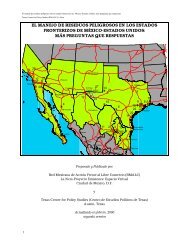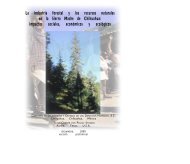Pesticides and Water Quality - Texas Center for Policy Studies
Pesticides and Water Quality - Texas Center for Policy Studies
Pesticides and Water Quality - Texas Center for Policy Studies
You also want an ePaper? Increase the reach of your titles
YUMPU automatically turns print PDFs into web optimized ePapers that Google loves.
The 1996 Assessment concluded that data on organics, including pesticides, are very limited within theColorado River basin. In fact, <strong>for</strong> all 45 segments studied, the data were insufficient to draw anyconclusions. 59 A fish consumption advisory is in effect <strong>for</strong> Segment 1429 (Town Lake in Austin) due topast applications of chlordane. 60The 1996 Assessment also questioned the “conventional wisdom which holds that agricultural practicesare the biggest single contributor to water quality problems.” 61 To that end, the LCRA conducted studiesof runoff from various agricultural sites below Austin in the lower sub-basin. The key findings of thosestudies were that: 1) two years is insufficient to reach many quantifiable conclusions; 2) total suspendedsolid levels were dramatically higher from row crop production compared to improved pasture l<strong>and</strong>; 3)nitrogen levels were generally elevated during the first runoff event following fertilizer application, butthen reached background levels; <strong>and</strong> 4) pesticides could only be detected in the runoff <strong>for</strong> about onemonth after application, indicative of the short half-life of many pesticides currently in use, such asmetolachlor <strong>and</strong> atrazine. 62 (The Assessments did not mention any studies or water monitoring data thatindicated that indicated the presence of either metolachlor or atrazine in the Colorado River Basin.)The 1996 Summary of the <strong>Water</strong> <strong>Quality</strong> Assessments prepared by the TNRCC stated that the “effects ofagricultural/rural non-point source pollution are currently being studied” <strong>for</strong> the Colorado River basinsegment running from Austin to Bay City. 63Cypress River BasinThe Cypress River Basin includes Caddo Lake, which is at the base of the Cypress Creek Basinwatershed. The 1996 Assessment report <strong>for</strong> this basin did not mention the collection of data or analysis<strong>for</strong> any pesticides.Guadalupe River Basin <strong>and</strong> the Lavaca/Guadalupe Coastal BasinThe 1994 report concluded that there was insufficient data <strong>for</strong> a complete assessment, particularly onorganics, though pesticides are used in the basin. The 1996 reports had no conclusive data on pesticides.Lavaca-Navidad River BasinThe 1994 Assessment <strong>for</strong> this basin concluded that water quality data on metals, toxics <strong>and</strong> pesticideswere not sufficient to draw any conclusions. For the last five years, the USGS has been sampling <strong>for</strong>pesticides <strong>and</strong> other pollutants in Lake Texana <strong>and</strong> more recently at four tributary sites. For morein<strong>for</strong>mation, refer to the Section on Special <strong>Studies</strong> conducted by USGS.Lower Neches River Basin <strong>and</strong> Trinity Coastal BasinThe 1992 Regional Assessment of the Lower Neches River Basin identified some possible concerns <strong>for</strong>pesticides. A 1987 Neches River study by the <strong>Texas</strong> <strong>Water</strong> Commission showed that dieldrin occurred inexcess of the human health criteria <strong>for</strong> ambient water. A 1992 Lower Neches Valley Authorityquestionnaire also stated that pesticides could be a problem in Segment 0701 (Taylor Bayou) due to a59 Lower Colorado River Authority, Regional Assessment of <strong>Water</strong> <strong>Quality</strong> Colorado River Basin <strong>and</strong> Colorado/Lavaca CoastalBasin. Technical Report (Austin: LCRA, 1996), 5.60 Ibid., Chapter B, Sub-watershed Issues, Austin-2.61 Lower Colorado River Authority, Regional Assessment of <strong>Water</strong> <strong>Quality</strong> Colorado River Basin <strong>and</strong> Colorado/Lavaca CoastalBasin, Executive Summary (Austin: LCRA, 1996), 3.62 Ibid., 3.63 TNRCC, <strong>Texas</strong> <strong>Water</strong> <strong>Quality</strong>: A Summary of River Basin Assessments (Austin: TNRCC, 1996), 78.25




